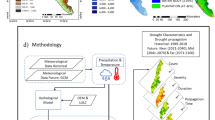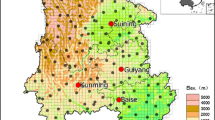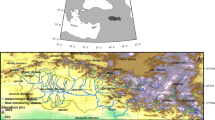Abstract
Climate change is one of the primary drivers that alters the natural balance of hydrologic cycle and leads to the onset of hydrologic extreme situations. In general, the climate change induces the hydrologic extreme drought more frequently as compared to the other catchment-scale hydrologic processes. In this context, it is indispensable to study the implications of climatic and catchment alterations on different types of drought processes. The present study analyzed the Standardized Precipitation Index (SPI), Standardized Precipitation Evapotranspiration Index (SPEI), Streamflow Drought Index (SDI), and Agricultural Standardized Precipitation Evapotranspiration Index (aSPEI) across multiple time scales of the future climate change scenarios. Further, this study attempted a correlation-based approach to identify the suitable drought index to characterize the agricultural drought and critical drought index estimates over the study region for both historical time periods and future climate change scenarios under different Representative Concentration Pathway (RCP) scenarios of RCP 4.5 and 8.5. The aSPEI is proved to be an improvement over the conventional SPEI for analyzing the agricultural drought characteristics across all the time scales. The 6-month time scale is found to be the most suitable reference period for drought monitoring with highest correlation estimate of 0.69 across all the three test locations. Individually, catchment and climate variables failed to represent the drought dynamics over the catchment, whereas the combined model adequately represented the drought dynamics. The relative impact of different process components revealed that the precipitation in the climate model and baseflow index in catchment model have significant impact on short-term drought prediction, while in the combined model, the baseflow index alone is sufficient. The methodology suggested herein could be adopted in any global catchment to represent the drought process, and subsequently, the drivers of drought could be identified with utmost accuracy.







Similar content being viewed by others
Data Availability
The data used in this paper can be obtained from the corresponding author with prior request.
References
Abbaspour KC, Vejdani M, Haghighat S, Yang J (2007) SWAT-CUP calibration and uncertainty programs for SWAT. MODSIM 2007 International Congress on Modelling and Simulation, Modelling and Simulation Society of Australia and New Zealand. 1596–1602
Abramowitz M, Stegun IA (1964) Handbook of mathematical functions with formulas, graphs, and mathematical tables. US Government Printing Office
Agnew C, Anderson E (1992) Water resources in the arid realm. Routledge
Akaike H (1974) A new look at the statistical model identification. IEEE Trans Autom Control 19:716–723
Bagley JE, Desai AR, Harding KJ, Snyder PK, Foley JA (2014) Drought and deforestation: has land cover change influenced recent precipitation extremes in the Amazon? J Clim 27:345–361
Bloomfield JP, Allen DJ, Griffiths KJ (2009) Examining geological controls on baseflow index (BFI) using regression analysis: An illustration from the Thames Basin. UK J Hydrol 373:164–176
Cammalleri C, Micale F, Vogt J (2016) A novel soil moisture-based drought severity index (DSI) combining water deficit magnitude and frequency. Hydrol Process 30(2):289–301
Dash SS, Sahoo B, Raghuwanshi NS (2020) A novel embedded pothole module for Soil and Water Assessment Tool (SWAT) improving streamflow estimation in paddy-dominated catchments. J Hydrol 588:125103
Dash SS, Sahoo B, Raghuwanshi NS (2021) How reliable are the evapotranspiration estimates by Soil and Water Assessment Tool (SWAT) and Variable Infiltration Capacity (VIC) models for catchment-scale drought assessment and irrigation planning? J Hydrol 592:125838
Dash SS, Sahoo B, Raghuwanshi NS (2019) A SWAT-Copula based approach for monitoring and assessment of drought propagation in an irrigation command. Ecol Eng 127:417–430
de Wit CT (1965) Photosynthesis of leaf canopies. Agric Res Rep 663, Wageningen: 1–57
Ebrahimpour M, Rahimi J, Nikkhah A, Bazrafshan J (2014) Monitoring agricultural drought using the standardized effective precipitation index. J Irrig Drain 141(1):04014044
Fu J, Niu J, Kang S, Adeloye AJ, Du T (2019) Crop production in the Hexi Corridor challenged by future climate change. J Hydrol 579:124197
Geng G, Wu J, Wang Q, Lei T, He B, Li X, Mo X, Luo H, Zhou H, Liu D (2016) Agricultural drought hazard analysis during 1980--2008: a global perspective. Int J Climatol 36:389–399
Golian S, Mazdiyasni O, AghaKouchak A (2015) Trends in meteorological and agricultural droughts in Iran. Theor Appl Climatol 119:679–688
Gudmundsson L, Bremnes JB, Haugen JE, Engen-Skaugen T (2012) Technical note: downscaling RCM precipitation to the station scale using statistical transformations & dash; a comparison of methods. Hydrol Earth Syst Sci 16:3383–3390
Heim RR Jr (2002) A review of twentieth-century drought indices used in the United States. Bull Am Meteorol Soc 83:1149–1166
Hong X, Guo S, Zhou Y, Xiong L (2015) Uncertainties in assessing hydrological drought using streamflow drought index for the upper Yangtze River basin. Stoch Environ Res Risk Assess, 29(4):1235–1247
Humphries P, Baldwin DS (2003) Drought and aquatic ecosystems: an introduction. Freshw Biol 48:1141–1146
International Benchmark Sites Network for Agrotechnology Transfer (IBSNAT) (1989) DSSAT version 2.1 user’s guide. College of Tropical Agriculture and Human Resources, University of Hawaii, Honolulu, Department of Agronomy and Soil Science
Keyantash JA, Dracup JA (2004) An aggregate drought index: Assessing drought severity based on fluctuations in the hydrologic cycle and surface water storage. Water Resour Res 40(9)
Konapala G, Mishra A (2020) Quantifying climate and catchment control on hydrological drought in the continental United States. Water Resour Res 56(1):e2018WR024620
Liu M, Li S, Wu J, He H, Huang H, Lü A (2015) Change of drought and its impact on potential yield of wheat in agricultural region of Shan-Gan-Ning region in 19612010. Trans Chinese Soc Agric Eng 31:147–154
McCown RL, Hammer GL, Hargreaves JNG, Holzworth DP, Freebairn DM (1996) APSIM: a novel software system for model development, model testing and simulation in agricultural systems research. Agric Syst 50(3):255–271
McKee TB, Doesken NJ, Kleist J (1993) The relationship of drought frequency and duration to time scales. Preprints, Eighth Conf. on Applied Climatology. Anaheim, CA, Amer Meteor Soc 179–184
Mishra AK, Singh VP (2010) A review of drought concepts. J Hydrol 391:202–216
Mishra V, Lilhare R (2016) Hydrologic sensitivity of Indian sub-continental river basins to climate change. Global Planet Change 139:78–96
Mohamed NM, Pandiyarajhan GK, Ravikumar G (2016) Drought analyzing techniques using various drought indices. In: International Conference on Current Research in Engineering Science and Technology (ICCREST-2016). E-ISSN: 2348-8352, 126–137
Moriasi DN, Arnold JG, Van Liew MW, Bingner RL, Harmel RD, Veith TL (2007) Model evaluation guidelines for systematic quantification of accuracy in watershed simulations. Trans ASABE, Am Soc Agric Biol Eng 50(3):885–900
Nalbantis I (2008) Evaluation of a hydrological drought index. Eur Water 23:67–77
Nalbantis I, Tsakiris G (2009) Assessment of hydrological drought revisited. Water Resour Manag 23:881–897
Narasimhan B, Srinivasan R (2005) Development and evaluation of Soil Moisture Deficit Index (SMDI) and Evapotranspiration Deficit Index (ETDI) for agricultural drought monitoring. Agric for Meteorol 133(1–4):69–88
Padhiary J, Patra KC, Dash SS, Uday Kumar A (2020) Climate change impact assessment on hydrological fluxes based on ensemble GCM outputs: a case study in eastern Indian River Basin. J Water Clim 11(4):1676–1694
Palmer WC (1968) Keeping track of crop moisture conditions, nationwide: the new crop moisture index
Palmer WC (1965) Meteorological drought (Vol. 30). US Department of Commerce, Weather Bureau
Quiring SM, Ganesh S (2010) Evaluating the utility of the Vegetation Condition Index (VCI) for monitoring meteorological drought in Texas. Agric for Meteorol 150:330–339
Shafer BA, Dezman LE (1982) Development of surface water supply index (SWSI) to assess the severity of drought condition in snowpack runoff areas. Proc Western Snow Conf
Sheffield J, Wood EF, Roderick ML (2012) Little change in global drought over the past 60 years. Nature 491:435–438
Smakhtin VU (2001) Low flow hydrology: a review. J Hydrol 240:147–186
Smith M (1992) CROPWAT: A computer program for irrigation planning and management. Food Agric Org
Sohrabi MM, Ryu JH, Abatzoglou J, Tracy J (2015) Development of soil moisture drought index to characterize droughts. J Hydrol Eng 20(11):04015025
Sperber KR, Annamalai H, Kang I-S, Kitoh A, Moise A, Turner A, Wang B, Zhou T (2013) The Asian summer monsoon: an intercomparison of CMIP5 vs. CMIP3 simulations of the late 20th century. Clim Dyn Springer 41(9–10):2711–2744
Stahl K (2001) Hydrological drought—a study across Europe. Doctoral dissertation, Geowissenschaftlichen Fakultät, Albert-Ludwigs Universität Freiburg, Freiburg, Germany
Tan ML, Ibrahim AL, Yusop Z, Chua VP, Chan NW (2017) Climate change impacts under CMIP5 RCP scenarios on water resources of the Kelantan River Basin. Malaysia Atmos Res 189:1–10
Teklay G, Ayana M (2014) Evaluation of irrigation water pricing systems on water productivity in Awash River basin, Ethiopia. Evaluation 4(7)
Themeßl MJ, Gobiet A, Leuprecht A (2011) Empirical-statistical downscaling and error correction of daily precipitation from regional climate models. Int J Climatol 31(10):1530–1544
Tigkas D, Tsakiris G (2015) Early estimation of drought impacts on rainfed wheat yield in Mediterranean climate. Environ Process 2(1):97–114
Tigkas D, Vangelis H, Tsakiris G (2019) Drought characterisation based on an agriculture-oriented standardised precipitation index. Theor Appl Climatol 135(3):1435–1447
Tsakiris G, Nalbantis I, Vangelis H, Verbeiren B, Huysmans M, Tychon B, Jacquemin I, Canters F, Vanderhaegen S, Engelen G, Poelmans L (2013) A system-based paradigm of drought analysis for operational management. Water Resour Manag 27(15):5281–5297
Tsakiris G, Pangalou D, Vangelis H (2007) Regional drought assessment based on the Reconnaissance Drought Index (RDI). Water Resour Manag 21:821–833
Uniyal B, Jha MK, Verma AK (2015) Parameter identification and uncertainty analysis for simulating streamflow in a river basin of Eastern India. Hydrol Process 29(17):3744–3766
Van Griensven A, Meixner T, Srinivasan R, Grunwald S (2008) Fit-for-purpose analysis of uncertainty using split-sampling evaluations. Hydrol Sci J 53(5):1090–1103
Vicente-Serrano SM, Beguería S, López-Moreno JI (2010) A multiscalar drought index sensitive to global warming: the standardized precipitation evapotranspiration index. J Clim 23:1696–1718
Wilhite DA, Neild RE (1981) Determining drought frequency and intensity on the basis of plant response: wild hay in the sand hills of Nebraska, USA. Agric Meteorol 25:257–265
Williams JR, Jones CA, Kiniry JR, Spanel DA (1989) The EPIC crop growth model. Transactions of the ASAE, 32(2):497–0511
Zhang L, Nan Z, Yu W, Ge Y (2016) Hydrological responses to land-use change scenarios under constant and changed climatic conditions. Environ Manag 57(2):412–431
Zhang X, Xu YP, Fu G (2014) Uncertainties in SWAT extreme flow simulation under climate change. J Hydrol 515:205–222
Acknowledgements
The authors have duly acknowledged the IMD, Bhubaneswar and CWC, Bhubaneswar for providing necessary hydro-meteorological data used in this study.
Funding
The authors declare that no funds, grants, or other supports were received during the preparation of this paper.
Author information
Authors and Affiliations
Contributions
J Padhiary: Software, Methodology, Analysis, Writing original draft. K C Patra: Conceptualization, Reviewing and editing Original Draft. S S Dash: Conceptualization, Methodology, Analysis, Reviewing and editing Original Draft.
Corresponding author
Ethics declarations
Ethical Approval
This paper has neither been published nor been under review for publication elsewhere.
Consent to Participate
The authors have participated in the preparation and submission of this paper for publication in the Water Resources Management.
Consent to Publish
The authors would like to publish their paper in Water Resources Management.
Competing Interests
The authors have no relevant fnancial or non-fnancial interests to disclose, and they have no conflicts of interest to declare that are relevant to the content of this paper and its publication.
Additional information
Publisher's Note
Springer Nature remains neutral with regard to jurisdictional claims in published maps and institutional affiliations.
Rights and permissions
Springer Nature or its licensor holds exclusive rights to this article under a publishing agreement with the author(s) or other rightsholder(s); author self-archiving of the accepted manuscript version of this article is solely governed by the terms of such publishing agreement and applicable law.
About this article
Cite this article
Padhiary, J., Patra, K.C. & Dash, S.S. A Novel Approach to Identify the Characteristics of Drought under Future Climate Change Scenario. Water Resour Manage 36, 5163–5189 (2022). https://doi.org/10.1007/s11269-022-03296-w
Received:
Accepted:
Published:
Issue Date:
DOI: https://doi.org/10.1007/s11269-022-03296-w




